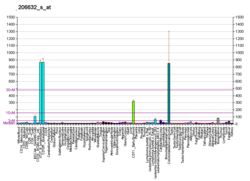| APOBEC3B | |||||||||||||||||||||||||||||||||||||||||||||||||||
|---|---|---|---|---|---|---|---|---|---|---|---|---|---|---|---|---|---|---|---|---|---|---|---|---|---|---|---|---|---|---|---|---|---|---|---|---|---|---|---|---|---|---|---|---|---|---|---|---|---|---|---|
| |||||||||||||||||||||||||||||||||||||||||||||||||||
| Identifiers | |||||||||||||||||||||||||||||||||||||||||||||||||||
| Aliases | APOBEC3B , A3B, APOBEC1L, ARCD3, ARP4, DJ742C19.2, PHRBNL, bK150C2.2, apolipoprotein B mRNA editing enzyme catalytic subunit 3B | ||||||||||||||||||||||||||||||||||||||||||||||||||
| External IDs | OMIM: 607110; MGI: 1933111; HomoloGene: 105420; GeneCards: APOBEC3B; OMA:APOBEC3B - orthologs | ||||||||||||||||||||||||||||||||||||||||||||||||||
| |||||||||||||||||||||||||||||||||||||||||||||||||||
| |||||||||||||||||||||||||||||||||||||||||||||||||||
| |||||||||||||||||||||||||||||||||||||||||||||||||||
| |||||||||||||||||||||||||||||||||||||||||||||||||||
| |||||||||||||||||||||||||||||||||||||||||||||||||||
| Wikidata | |||||||||||||||||||||||||||||||||||||||||||||||||||
| |||||||||||||||||||||||||||||||||||||||||||||||||||
Probable DNA dC->dU-editing enzyme APOBEC-3B is a protein that in humans is encoded by the APOBEC3B gene. [5] [6] [7]
Contents
This gene is a member of the cytidine deaminase gene family. It is one of seven related genes or pseudogenes found in a cluster, thought to result from gene duplication, on chromosome 22. Members of the cluster encode proteins that are structurally and functionally related to the C to U RNA-editing cytidine deaminase APOBEC1. It is thought that the proteins may be RNA editing enzymes and have roles in growth or cell cycle control. This gene along with APOBEC3A have been in recent years found associated with mutagenesis of several cancers. The APOBEC3A and APOBEC3B proteins can cause specific mutations in cancer genomes called APOBEC mutagenesis and several factors including genetic and environmental influence this mutation pattern among patients specifically in bladder and breast cancer. [7] This gene is also overexpressed in multiple myeloma, possibly aiding its formation. [8]




